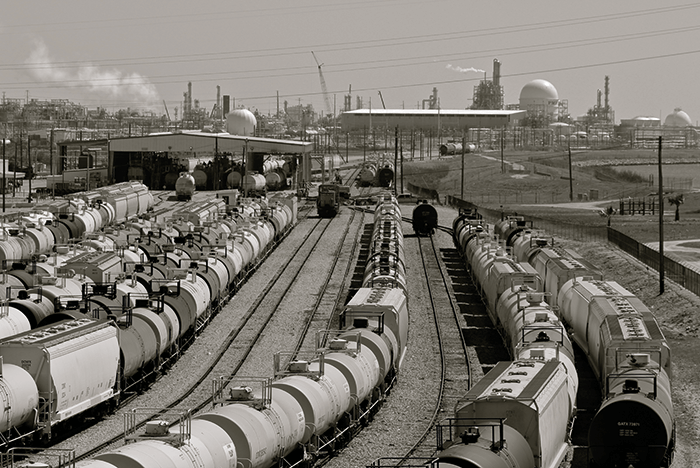By Roy Luck (Dow Chemical plant and railcars) [CC BY 2.0], via Wikimedia Commons

A Vision for VUV
By Bill Winniford, Fellow, The Dow Chemical Company, Houston, Texas, USA. We started on our vacuum ultraviolet journey about the same time as the University of Texas at Arlington – right at the beginning of March 2010. The experience so far is probably the most useful thing that’s ever come out of being on LinkedIn. Sean Jameson contacted me as they were considering the potential of VUV detection for gas chromatography (GC) – even before they had constructed an instrument. They were looking for someone in driving distance of Austin with industrial experience, and found my name. It was a complete cold call, but my interest was piqued by the concept. In particular, I wanted to find out about the potential jump in sensitivity over GC-IR. And so, Sean and Dale Harrison (the two founders of VUV Analytics) drove down to meet me for lunch. It’s not uncommon to be contacted by start-up companies looking for guidance, but in that first meeting I was impressed with the knowledge level of the team – and I acknowledged that there were far worse ways of spending a lunch break...A rude awakening
Once the VUV Analytics team had a working system in their laboratory, they asked us to send representative samples for analysis. We were particularly interested in catalyst poisons and gathered up a whole set of samples, including a number of oxygenated species – alcohols, aldehydes and ketones, and so on. We assembled a large team of people (all with high expectations) to review the results and I have to say that it was the single most disappointing time of the whole endeavor (which is fortunate, with full hindsight)! We were expecting to see a lot of distinction between spectra for aliphatic alcohols, but it turns out that they are probably the least interesting compounds in terms of obvious VUV spectral features. Looking back, it’s funny – we had no appreciation of the excellent spectral reproducibility and, on the other hand, the VUV guys, with their in-depth knowledge, were excited with the results and must have been confused with our initial disappointment. Despite the hiccup, they did demonstrate one very important proof: the VUV detector was capable of good sensitivity at a timescale that gave excellent chromatographic resolution – facts that have maintained our interest ever since. After that, the team would show up periodically to share their latest results and we’d offer iterative feedback, and in October 2012, we took delivery of the first beta-test VUV instrument. And of all the beta instruments I’ve worked with, I can say it was by far the best.Running the full gamut
Once we had the detector in house, we threw every sample class we could at it to see if we could start to make any generalizations about VUV detection. Two important points that may not be immediately obvious became clear:The detector response (if you look at the average response over a range of 140–160 nm, for example) is surprisingly uniform. Those who have worked with LC-UV detection will know that you typically don’t expect to get a uniform response. The upshot is that on a first pass, you can do rough quantitation without calibration, which is incredibly useful. Because the spectra don’t appear to be very distinct, most people would assume that either they aren’t useful, will make library searching difficult or would be sensitive to matrix effects (remember ‘Rude Awakening’ above). In reality, the spectra are remarkably rock solid. And that means that even if spectra appear to differ only slightly, they can still be accurately library matched, which is a huge – and somewhat unexpected – advantage. Moreover, we have yet to see any matrix effects. Even the temperature of the flow cell, which you might envisage impacting electron transitions, seems to have very little effect on spectra stability. Over time, another really important point popped out: it does a great job of distinguishing between isomers. And though it has caused a little controversy in certain circles, we’ve had real success in using computational tools to model spectra to predict differences between isomers; useful trends become apparent when using the system, such as the fact that a conjugated diene will have a certain spectral feature out at a longer wavelength than an unconjugated diene. It’s a tremendously powerful tool for investigating trace levels of unknown components in a matrix – say an odor, color or catalyst species. With VUV detection, we can get useful spectra down to part-per-million levels of sensitivity, and we stand to gain information that is very complementary to mass spectral data – especially important when it comes to problem solving. One of my main roles is to seek out new technology and techniques that can solve the analytical challenges we face – and I can state that we’ve also found the combination of GC×GC with VUV detection very helpful in this regard. All good news, but any start-up analytical company needs a sponsoring application – either something that no one else can do or something that it does so much better or more cost effectively. In the hydrocarbon world alone, the VUV detector has proven itself with the ability to distinguish olefins and aromatics from aliphatics – that’s a killer application given the complexity and time involved using any other technique. The VUV detector’s ability to perform a more accurate and much more robust PIONA analysis is an important milestone in its ongoing success.





